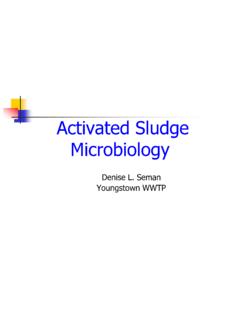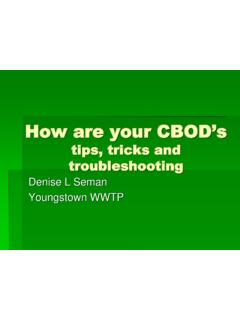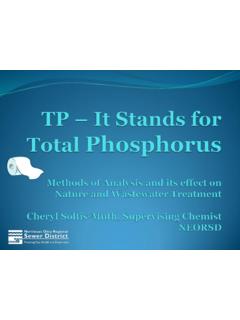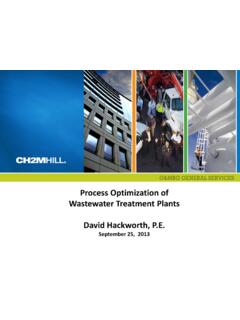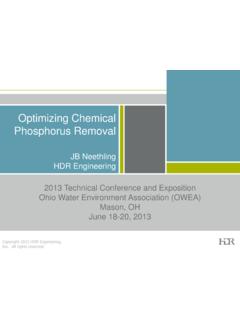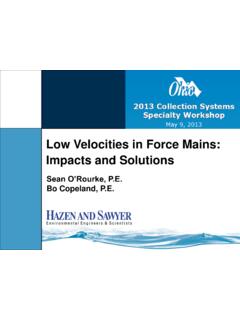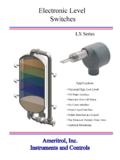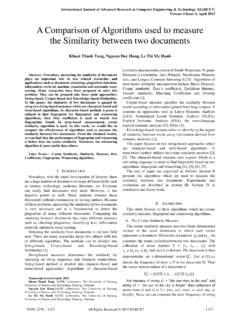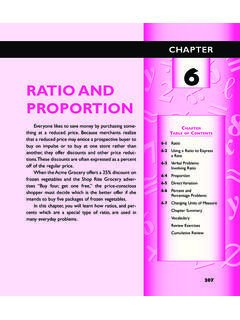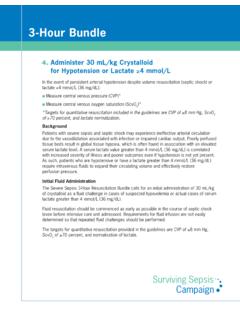Transcription of E. coli Analysis in Wastewater by Quanti-Tray, …
1 11E. coli Analysis in Wastewater by Quanti- tray , Method 9223 B Amy StaleyAllowayE. coli happensE. coliHappensFecal Coliform Group- group of total coliform bacteriafound in intestinal tracts of warm-blooded coli-a species of bacteria within the fecal coliform group-dominant bacteria found in waste of humans and warm-blooded a positive total coliform response-possess an enzyme called ( -glucoronidase) which releases fluorogen that is detected using a 365 nm UV coli( E. coli) Why test for E. coliand not just Fecal Coliforms? Because we are now required to. As NPDES permits are renewed E. coliwill be added. Fecal coliform requirements are being phased out and qgpE. colilimits and monitoring requirements are being put in place E. colihas been shown to be a better predictor of the potential for impacts to human health from exposure to waste effluent and surface waters which contain Wastewater coli as an indicator organism Determines the sanitary quality of water Impossible to test for ALL pathogenic microorganisms, so test for easily detectable indicator organisms.
2 Hundreds of E. colistrains Most are non pathogenic (some beneficial) Some pathogenic strains Although generally not pathogenic, their presence indicates a pathwayfor human pathogen (ex. Viruses, bacteria) to enter the water colias an indicator organism Ideal indicator organism for testing water for fecal contamination Ability to survive for brief periods outside of the body Other fecal coliforms can arise from environmental factors (not lltffltiti)Kl b i llalways a result of fecal contamination) ex. colias an indicator organism Not all E. colicomes from humans Different strains from different species (ex. Humans, birds, cows, ) Most harmful pathogenic strain, E. coli O157:H7, found in cow intestinesintestines ex. Food poisoning Can NOT be detected using standard fecal coliform methods .
3 Differentiation may be necessary to pinpoint source of contamination Performed by specialized coli( E. coli) Primary Body Contact Recreation: E. coli is a more accurate indicator of fecal contamination than the fecal coliform group. A positive relationship exists between E. coli density in tiltdbf bdrecreational waters and numbers of observed gastrointestinal illnesses. Lack of a positive relationship between fecal coliform group and gastrointestinal illness. Ohio Revised Code 3745-1-07 identifies criteria for recreation uses Applies to inside and outside the mixing zone Applies at all times during recreation seasonEscherichia coli( E. coli) 3745-1-07 has updated classifications Class A primary contact paddling streams, public/private access points, frequent recreational activity Class B primary contact occasional primary contact, non pypy,paddling, non bathing waters, occasional recreational activity Class C primary contact infrequent primary contact, wading, very small drainage area (< square miles) Secondary contact recreation minimal exposure potential Insufficient depth to provide full body immersion Rarely used for recreationEscherichia coli( E.)
4 Coli)Escherichia coli( E. coli) EPA approved methods for testing for E. coli in Wastewater include: Membrane filter (MF) ebae te( )EPA Method 1603 (m-TEC media)HACH Method 10029 ( mColiblue 24 media) Multiple tube/ multi-well procedures Standard methods 9223 B (Enzyme Substrate)Quanti- tray and Quanti- tray /2000 Enzyme Substrate methods Enzyme based methodologies detect both total coliformsand E. colisimultaneously. Easy, rapid, accurate Widely accepted as standard for microbiological Analysis of water. Enzymes for Quanti- tray method: Colilert, Colisure,Colilert-1833 Enzyme Substrate MethodsColilert: Enhancements for enzyme expression Traditional media provides a nutrient rich environment that supports the growth of both target and non target ih ttdiittorganisms, when non targets grow and mimic target organisms false positives occurGrowth of non targets can also suppress target organism and give false negative in traditional mediaTo suppress non target organisms, traditional media often include high levels of salts, detergents and other selective agents which may inadvertently suppress target organisms and give false Substrate MethodsColilert.
5 Ability to detect either presence/absence or to enumerate a single, viable organism per sample Suppression of non-coliformsEx. AntibioticsSuppresses up to 2 million heterotrophs per 100 mlEnzyme Substrate MethodsBenefitsof Quanti- tray Detects down to one organism per 100 mL No dilutions (for counts to 200/100mL or 2,419/100 mL)No dilutions (for counts to 200/100mL or 2,419/100 mL) Results in 24 hours No confirmation necessary If no dilutions are used: No glassware to purchase and cleanEquipment Needed forMethod 9223 BAutoclave Sterilize TSB media for 15 minutes at 119 - 121 Sterilize blank water< 500 ml = 30 mins> 500 ml = 45 minsEquipmentAutoclave Supplies Autoclave tapeAutoclave bags : run waste Autoclave bags : run waste cycle 45 mins at proper temp.
6 Autoclave biological indicator(monthly QC) Log book: record time in/out, temp., cycle timeAutoclave tapeAutoclave tapeAutoclave bagsAutoclave bagsBT Sure Biological BT Sure Biological IndicatorIndicatorEquipmentRefrigerator Storage of reagents at 0 -5 CTSB mediaTSB mediaBacterial culturesex. Kwik StiksRefrigerator 0 Refrigerator 0--55 C C44 EquipmentOven Sterilize measuring glassware for 2 hrs. at 180 Cpipettespipettesgraduated cylinders Supplies:aluminum foilEquipmentIncubator Incubate Quanti-Trays forEcolianalysis at 35 C +/E. colianalysis at 35 C + C for indicated amount of timeIncubator 35 Incubator 35 C +/ C + EquipmentTesting Supplies Quanti- tray sealer and rubber inserts Quanti- tray (51 wells)range: 1-200 MPN/100 mlsOR Quanti- tray 2000 (97 wells)range: 1-2419 MPN/100 mlsQuantiQuanti-- tray Sealer andTray Sealer andrubber insertsrubber insertsQuantiQuanti-- tray / QuantiTray / Quanti-- tray 2000 tray 2000 EquipmentTesting Supplies (cont.)
7 Pre-sterilized clear sample bottles with dechlorination chemicalsSterile sample bottleSterile sample bottle Squeeze bottles for blank water- used for dilutions Enzymes- ex. Colilert Long wave UV lampSqueeze bottles Squeeze bottles Long wave UV lampLong wave UV lamp365365--366 nm 366 nm EquipmentMeasuring Items Sterile graduated cylindersSterile pipettes Sterile pipettes Balance for weighing dry media - if preparing TSBS terile graduated cylindersSterile graduated cylindersSterile pipettesSterile pipettesBalance Balance EquipmentMisc. Items Pipette washerConductivity meter Conductivity meter-monthly QC of blank water pH meter-for checking pH of TSB Pipette washerPipette washerpH meterpH meterConductivity Conductivity metermeter55 Reagents and Standards Colilert Snap packs for sample size 100 ML Sample turnsyellowwhen totalcoliformbacteria are presentSample turns yellowwhen total coliformbacteria are present and fluoresces blueto indicate the presence of E.
8 ColiReagents and Standards Distilled Water/RODI Water Do NOTuse phosphate buffered rinse water with this method pH Buffers For calibration of pH meter used for monthly QC of RODI water DPD reagent packets For determination of residual chlorine (monthly QC on RODI water) Conductivity Standard For Calibration of conductivity meter used for monthly QC of RODI waterReagents and Standards Bacterial Cultures QC for mediaEx: Microbiologic Kwik Stiks Ex: Microbiologic Kwik Stiks TSB media (tryptic soy broth) QC for bottles Can be purchased premade or as a dry mediaTSB media TSB dry mediaTSB dry mediaReagents and Standards Autoclave Biological Indicator Checks QC for Autoclave Clorox Bleach Disinfection of counter and spills Colilert comparator Pre-dispensed in either types of Quanti- tray Used for determination of positive result Kwik SticksSample Collection Samples to be representative of the water being tested Use aseptic technique for collection Keep sample container ldtillltibiclosed until collection begins Avoid contact with inside of bottle and/or cap Collect directly into sterile container containing de-chlorinate agent Do not rinse the bottle Leave air space to allow for mixingSample Collection If not
9 Analyzed immediately: Cool sample to <10 C Ideally Analysis within 2 hours of collection is preferredof collection is preferred Sample must be analyzed within 6 hours of collection. New EPA amendment states lab can analyze within 8 hours of collection if sample is not able to be delivered to lab within the 6 hour hold Turn on Quanti- tray Sealer-Warm up time approx. 10 mins. Vigorously shake water sample bottle 25 times within 7 between shaking and measuring the test portion should not exceed 3 remove lid and adjust sample volume to the calibrated 100 ml line on sample container: (this is for use of 100 mls of sample)ProcedureNeed Dilutions?Dilutions may also be used in which case you do NOT need to pour off excess water. Test requires the use of 100 ml of sample: Ex.
10 1:10 dilution; use 10 ml sample: 90 ml blank water Final results must be multiplied by the applicable dilution Aseptically add 1 packet of Colilert reagent to the 100 ml test bottle**If sample flashes blue: excessive chlorine and invalid for Analysis Re-cap the bottle and shake until reagent is mostly dissolved. Label back of tray with sample ID and dilution usedProcedure Use one hand to hold open the Quanti- tray or Quanti- tray /2000 Well side is facing the palm of the hand. Squeeze upper part of tray so it bends toward the palm. Gently pull foil tab to open the tray . Avoid touching inside of tray or foil tab. Pour 100 ml sample into the Tap small wells 2-3 times to release air bubbles. Place tray with sample into rubber insert so that wells sit within the cutouts Place rubber insert on the input shelf of sealer.

